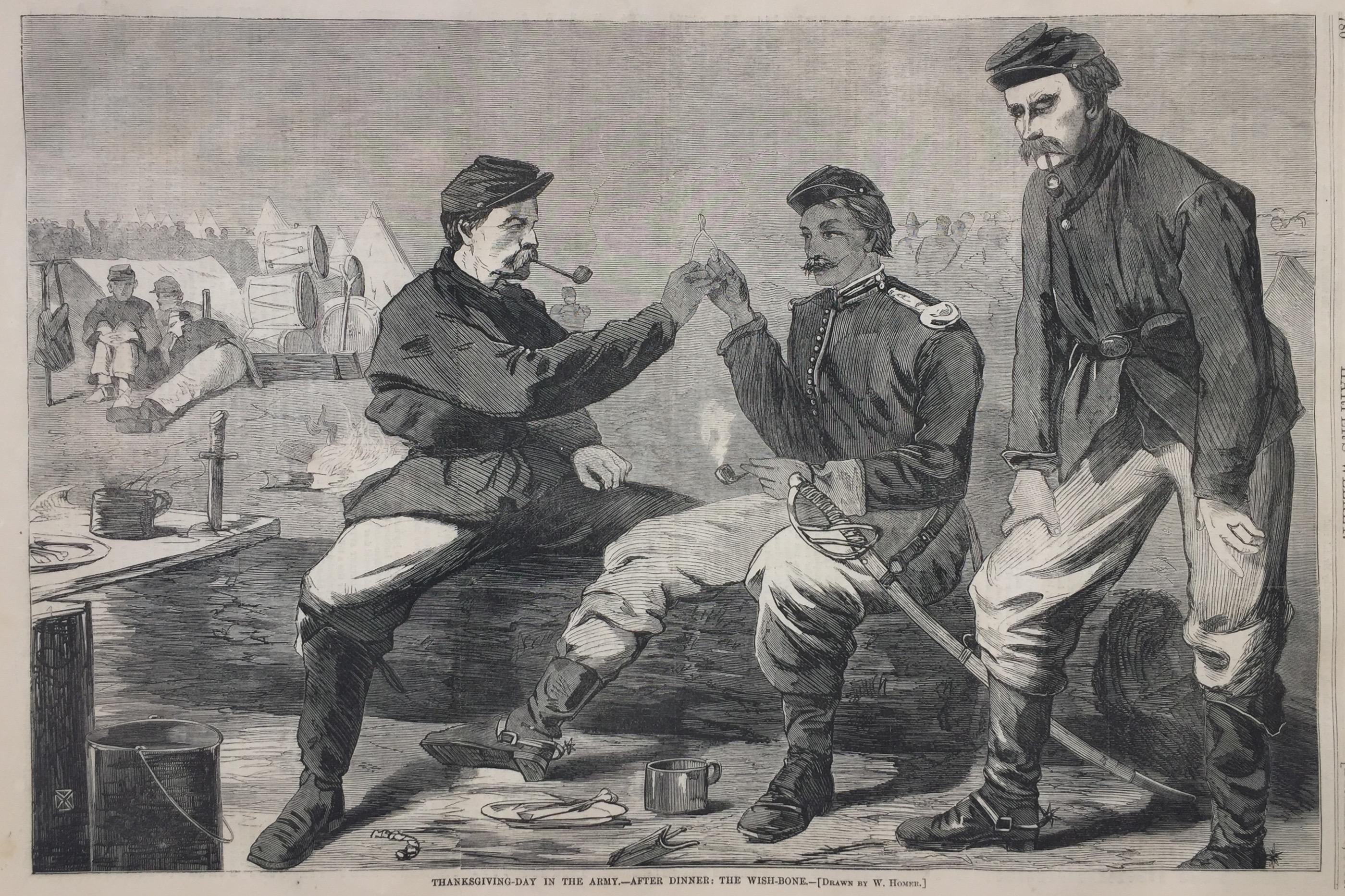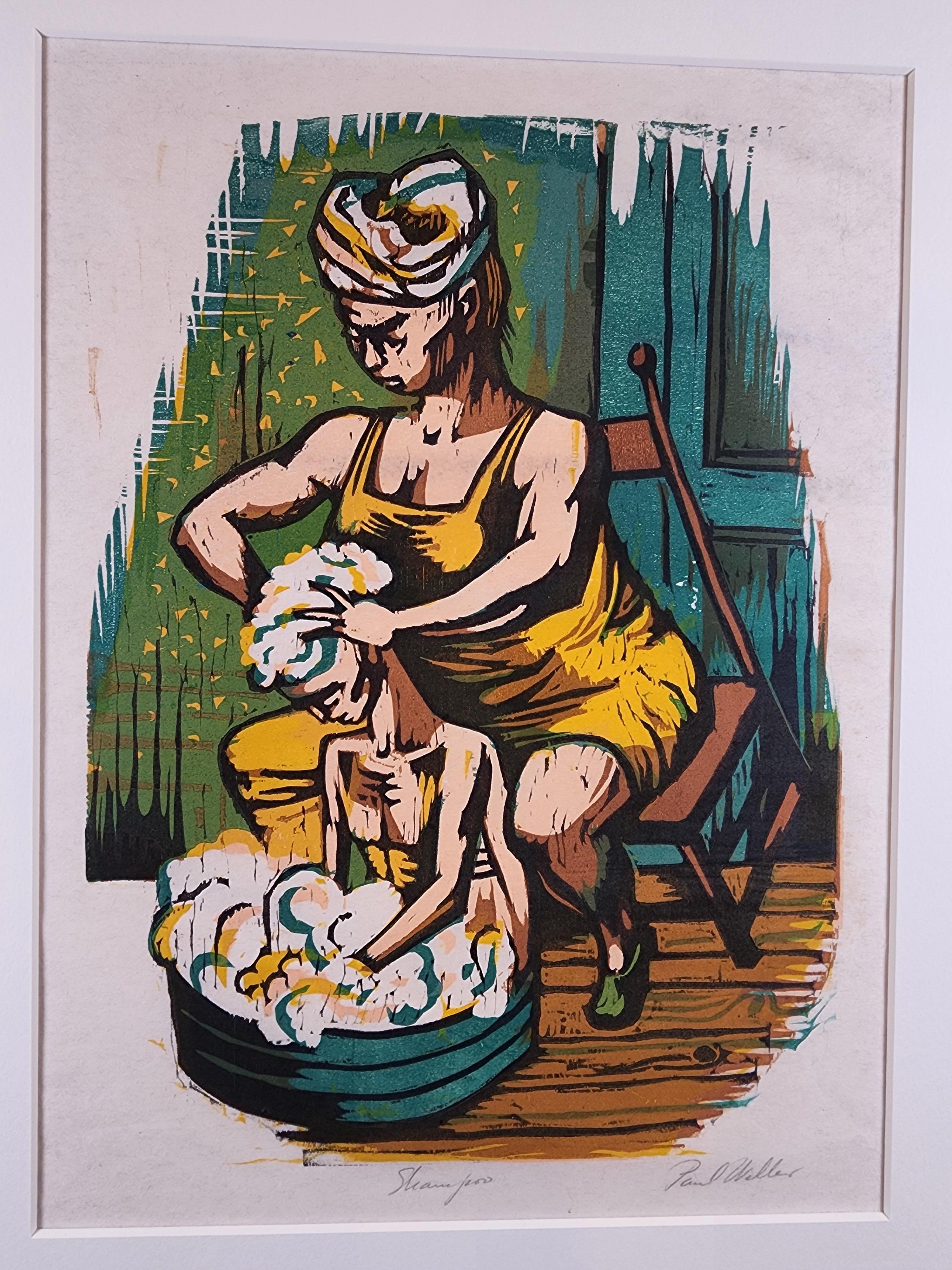Want more images or videos?
Request additional images or videos from the seller
1 of 10
Winslow HomerThe Bathers1873
1873
About the Item
The Bathers
Woodengraving, 1873
As published in Harper's Weekly, August 2, 1873 (p. 668)
Provenance:
Wunderlich & Co., Inc., New York, NY (Their stock no. 84.003.8 in pencil recto and verso)
Condition: Very good
Usual centerfold from the newspaper
aging to the paper (usual)
Image size: 13-7/8 x 9-1/4" (35.4 x 23.7 cm)
Sheet size: 15 7/8 x 11"
Reference: Beam 199
Goodrich 75
Kushner, Gallati & Ferber 71
"Winslow Homer’s wood engravings resulted from a collaborative process that involved many hands and transformed his designs into metal (electrotype) printing plates. To begin, Homer usually drew on a prepared, end-grain boxwood block—most often consisting of smaller pieces of wood bolted together. A team of professional wood engravers then incised the blocks.
Next, pictorial and text components were arranged into a page layout and a wax mold was made of the whole. This mold was coated with powdered graphite and placed in an electrically charged chemical bath together with plates of copper. The chemicals and electric current caused copper particles to form on the graphite coating, creating a precise metal replica of the page’s type and engraved images. This replica, reinforced with various metals, was then used to print the images we call wood engravings.
Courtesy The Clark
"Winslow Homer (1836-1910) was an American landscape, marine and genre artist. A master of oil painting and watercolor, he was also a gifted printmaker, illustrator and pictorial journalist. Born in Boston, the artist received no real formal training with the exception of some life-drawing classes at the National Gallery of Design and a stint studying painting with Frédéric Rondel in 1861. From 1859 until the mid-1870s, Homer worked as a commercial illustrator. During the Civil War, the artist gained international public recognition for his pictorial documentation of the battlefield commissioned by Harper's Weekly.
Post-war, Homer traveled first to Europe then returned to the States to establish a studio in New York City. There he began executing illustrations depicting vignettes from everyday life. The public embraced the authenticity of these portrayals as embodying the democratic spirit, considering them a visual similarity to the poetry of Walt Whitman at that time. Although popular and successful, in 1876 Homer abandoned commercial work, devoting attention to painting his vision of the American scene full-time.
Homer's subject matter included landscape and rural genre scenes, but he also found inspiration in the sea and traveled extensively to coastal locations - England, Cuba, the Caribbean, the Bahamas, Florida and Prouts Neck, Maine where he eventually would live out his life. His dramatic and forceful renderings of the Atlantic seascape remain unsurpassed and some of his most celebrated paintings. The Adirondack Mountains were an additional important destination. For 35 years the artist found inspiration for his work in the rugged terrain, the life of the outdoorsman and the natural beauty of the region.
In the last fifteen years of his life, Homer was revered as the nation's foremost painter. At the time of his death, Homer's work was represented in more public collections than any other living American artist. Considered by many to be 19th century America's most gifted artist, Homer's works are often viewed as embodying the beginnings of a truly "national" art that adopted the American experience as its subject matter. His ability to capture the spirit of America through images characterized by their directness, realism, subjectivity and color, resonate with the nation and hold a special position in the history of American art."
Courtesy: The Hyde Collection Museum, Glens Falls, NY
- Creator:Winslow Homer (1836 - 1910, American)
- Creation Year:1873
- Dimensions:Height: 15.875 in (40.33 cm)Width: 11 in (27.94 cm)
- Medium:
- Movement & Style:
- Period:
- Condition:Original.
- Gallery Location:Fairlawn, OH
- Reference Number:
Winslow Homer
Winslow Homer (1836-1910) was an American landscape painter, printmaker and publication illustrator. He is considered one of the most important American artists of the 19th-century. Largely self-taught Homer initially worked as an illustrator for various publications, including: Harper's Weekly, Frank Leslie's Illustrated Newspaper and Ballou's Pictorial Magazine. He worked for Harper's during the Civil War, producing woodcut engravings depicting the personal experiences of soldiers. He later became a master of oil and watercolor painting, often focussing on maritime themes. Harper’s Weekly, published in New York, was an extremely popular publication in the nineteenth and early twentieth centuries. In weekly issues Harper’s reported the news, entertained with literature, poetry and art, as well as educating its readers about world affairs and new inventions. It's woodcut engraved illustrations and literature added to its popularity, employing major artists and authors of the time, including Winslow Homer, Charles Dickens, William Makepeace Thackeray and Thomas Nast.
About the Seller
5.0
Recognized Seller
These prestigious sellers are industry leaders and represent the highest echelon for item quality and design.
Platinum Seller
These expertly vetted sellers are 1stDibs' most experienced sellers and are rated highest by our customers.
Established in 1978
1stDibs seller since 2013
712 sales on 1stDibs
Typical response time: 1 hour
Associations
International Fine Print Dealers Association
- ShippingRetrieving quote...Ships From: Fairlawn , OH
- Return PolicyA return for this item may be initiated within 10 days of delivery.
More From This SellerView All
- Keresan DancersBy Gene KlossLocated in Fairlawn, OHKeresan Dancers Etching & drypoint, 1962 Signed lower right (see photo) Inscribed lower left: "Artist's Proof Keresan Dancers" Depicts Keresan speaking peoples at Sam Felipe Pue...Category
1960s American Realist Figurative Prints
MaterialsDrypoint
- Meditation and MinouBy Will BarnetLocated in Fairlawn, OHMeditation and Minou Color lithograph and serigraph, 1980 Signed and numbered in pencil (see photo) Printer Styria Studio, Inc. New York Publisher: Harry Abrams...Category
1980s American Realist Figurative Prints
MaterialsScreen
- WARNING! Register*Vote, INFLATION means DEPRESSIONBy Ben ShahnLocated in Fairlawn, OHWARNING! Register*Vote, INFLATION means DEPRESSION Photo lithograph, 1946 Signed in the image lower left Published by CIO (Congress of Industrial Organizations) before their merger w...Category
1940s American Realist Figurative Prints
MaterialsOffset
- The Hold Up, First StateBy George Wesley BellowsLocated in Fairlawn, OHSigned in pencil by the artist lower right Titled "Hold Up" by the artist in pencil. Signed by the printer Bolton Brown lower left. Edition: 42 in this state Note: In The Hold Up, se...Category
1920s American Realist Figurative Prints
MaterialsLithograph
- Darius at 10By Darius StewardLocated in Fairlawn, OHDarius at 10 Drypoint, 2022 Signed, titled and numbered in pencil Printed by Rebekah Wilhelm Her drystamp lower right Published by the artist Edition 14, plus pr...Category
2010s American Realist Figurative Prints
MaterialsDrypoint
- Broadway ParadeBy Adolf DehnLocated in Fairlawn, OHBroadway Parade Lithograph, 1934-1935 Signed, titled and editoned in pencil (see photos) Printer: George Miller, New York Edition: 100, plus trial proofs Printed on cine collee Creat...Category
1930s American Realist Figurative Prints
MaterialsLithograph
You May Also Like
- Wpa Woman Laborer woodblock printBy Albert AbramovitzLocated in Surfside, FLoriginal limited edition woodcut woodblock print great depression era. (possibly a Moscow, Russia piece) signed in plate with monogram cipher mark. from the 1930s. Abramovitz, Albert 1879-1963 Born in Riga, Latvia, Abramovitz studied art at the Imperial Art School in Odessa and at the Grande Chaumière in Paris. In Paris, he became a member of the Salon in 1911 and in 1913 he became a member of its jury. He also became a member of the Salon d'Automne. While in Europe he received a medal at Clichy as well as the Grand Prize at the Universal Exhibition in Rome and Turin, Italy in 1911. In 1916, Abramovitz emigrated to America settling...Category
1930s American Realist Figurative Prints
MaterialsWoodcut
- THANKSGIVING IN CAMPBy Winslow HomerLocated in Santa Monica, CAAFTER - WINSLOW HOMER (1836-1910) THANKSGIVING IN THE ARMY - After Dinner: the Wishbone, 1864 Original wood engraving as published by Harpers Weekly December 3, 1864, after a drawing by Winslow Homer. Image 9 3/4" x 14, Sheet 10 3.\/4 x 15 3/4" . Generally good condition, a small stain in the upper right margin. Homer contributed drawings to Harper's Weekly from 1857 to 1875. They were converted to wood engravings by Harper's craftsman and published in Harper's Weekly. Although after his original drawings, they are now accepted as an important part of his body of work by museums and collectors. They were very large editions. As such, they occur often in the marketplace. Harper's published during the Civil War years as this was, were widely read and kept as people followed the war first hand and its aftermath over the years continuing today as both Homer and Civil War collectablesCategory
1860s American Realist Figurative Prints
MaterialsWoodcut
- ShampooLocated in Raleigh, NCRgrFineArts is pleased to offer this New York WPA color woodcut by Paul Weller titled Shampoo. The WPA label is affixed to the margin on the reverse of the print.Category
1940s American Realist Figurative Prints
MaterialsWoodcut
- Iris at DuskLocated in San Francisco, CAThis artwork titled "Iris at Dusk" 1980 is an original color woodblock print with embossing by American artist Daniel Joshua Goldstein, b.1950....Category
Late 20th Century American Realist Landscape Prints
MaterialsWoodcut
- TrumpeteersLocated in San Francisco, CAThis artwork titled "Trumpeteers" 1976 is an original wood engraving by Russian/American artist Leon Gilmour, 1907-1996. It is hand signed, titled, dated ...Category
Late 20th Century American Realist Figurative Prints
MaterialsWoodcut
- Tatoo-Shave-HaircutBy Reginald MarshLocated in New York, NYReginald Marsh (1898-1934), Tattoo-Shave-Haircut, etching, 1932. Signed, titled (“Tattoo-Haircut-Shave”), dedicated (“for Arnold Newman”), and annotated (“Fourth State. First of Two Prints”). Reference: Sasowsky 140. On cream wove paper. In very good condition, with small margins (as trimmed, slightly irregularly, by the artist) (slight foxing in margins), remains of prior hinging verso; 9 7/8 x 9 3/4, the sheet 10 15/16 x 10 5/8 inches; archival matting. A very fine rich black impression; we have not seen impressions of comparable quality on the market. Provenance: Estate of Arnold Newman. Arnold Newman (1918-2006) was one of the great 20th Century masters of photography, and a friend of many leading artists; it is appears that Marsh took special care in printing this impression for Newman. Sasowsky calls for 10 states of Tattoo-Shave, based largely on Marsh’s notes. But the states are not clearly delineated (e.g., his States 3 and 4, one proof each, are characterized by Marsh as “Engraving added”; no information is given for State 5). The design for the print was complete in the first state, and subsequent state changes were not, apparently, major. This impression does not appear to differ in etching lines from the final state impression shown in Sasowsky. Its inscription (as a Fourth State, by Marsh), as well as its rich inking and quality, attest to its being a proof before the edition (of about 34 impressions), but the state of this print (and, presumably of many of the other several proof impressions) cannot at this time be stated with confidence. Marsh printed this impression personally (we recall his famous answer to a question about the size of his editions: “Since I do practically all my own printing, I do not limit the edition. The buyer limits the edition – he rarely buys, I rarely print”). Tattoo-Shave-Haircut depicts a scene in the Bowery, a section of New York’s Lower East Side, during the Great Depression. The building and train structures in the top half of the print recall Piranesi’s Carceri...Category
1930s American Realist Figurative Prints
MaterialsEtching
Recently Viewed
View AllMore Ways To Browse
Civil War Prints
Antique New England Homes
The American Civil War
American Civil War Art Print
Antique Print Block
Antique Civil War Prints
Death Newspaper
Clarks England
Adirondack Mountains
Antique Replicas
Antique Prints Boston
Replica Collection
Everyday Plates
Museum Replica
American Wood Block Prints
Antique Caribbean
Antique Wood Print Blocks
Landscape Wood Block Print



